Colour temperature. Part 1: Circadian cycle
Is there a perfect colour temperature for every project? The answer is YES, but in practice the colour temperature of light sources is always a very personal decision where the client does not always follow “recommendations” but rather their own feelings.
Before we begin, we must define and distinguish between two aspects of “colour”. Is colour temperature the same as CRI? No. They are two different concepts, but we must understand that they often go hand in hand.
What is colour temperature?
Without getting too technical, colour temperature is the hue emitted by a light source and is represented in degrees Kelvin. This measurement will tell us whether the light will be cold or warm:
- <<3200ºK = warm light
- 3200º-5000ºK = neutral light
- >>5000ºk = cold light
What is a CRI?
Es un valor numérico que representa la fidelidad de una fuente de luz al reproducir el color de una superficie u objeto. Se toma como base el CRI del sol que seria CRI 100. Se considera que las fuentes de luz tienen un buen CRI a partir de un CRI>80.
What are the most common colour temperatures?
We need to bear in mind that since the discovery of fire, humans have gone from living according to the rhythm of the circadian cycle marked by day and night to being able to also “live” during the period of time marked by night. Furthermore, with the evolution of light sources we have seen how the colour temperatures we can achieve have increased exponentially:
- Candle à 2000ºK
- Incandescence à 2700ºK
- Halogen à 3000ºK
- Low consumption and fluorescence à 2700ºK – 6500ºK
- LED à 1800ºK-6500ºK (most used temperatures)
- Sunlight moves through numerous temperature ranges throughout the day. For example, at midday on a clear day the measurable colour temperature is 5500ºK, whereas on a cloudy day it can be between 6500ºK-7500ºK.
What colour temperature is “best”?
This is a very common question, but as we said at the beginning of this post, it is usually a very personal decision, because each person feels more comfortable with one temperature or another. In any case, in order to “recommend” a colour temperature, we could consider two factors:
- · Task type: Working in an office is not the same as relaxing at home on the couch at the end of the day. We must remember that each task requires a different type of light.
- · Circadian cycle: making the most of natural light, always.
What is the circadian cycle?
It is the natural cycle of physical, mental and behavioural changes that the body experiences in a 24-hour period. Circadian rhythms are primarily affected by light and darkness.
A cold colour temperature (i.e., greater than 5000ºK) generates different physical and chemical reactions in our body:
- · Melatonin suppression
- Increased body temperature
- · Increased heart rate
- · Reduced drowsiness
- · Increased state of alert
However, a warm temperature (i.e., less than 3000ºK):
- · Promotes the secretion of melatonin
- · Promotes relaxation
Taking into account this information and all the progress being made in Neuro lighting, it is important to remember that our body and the activities we carry out should be linked to the circadian cycle and the different colour temperatures we need throughout the day.



